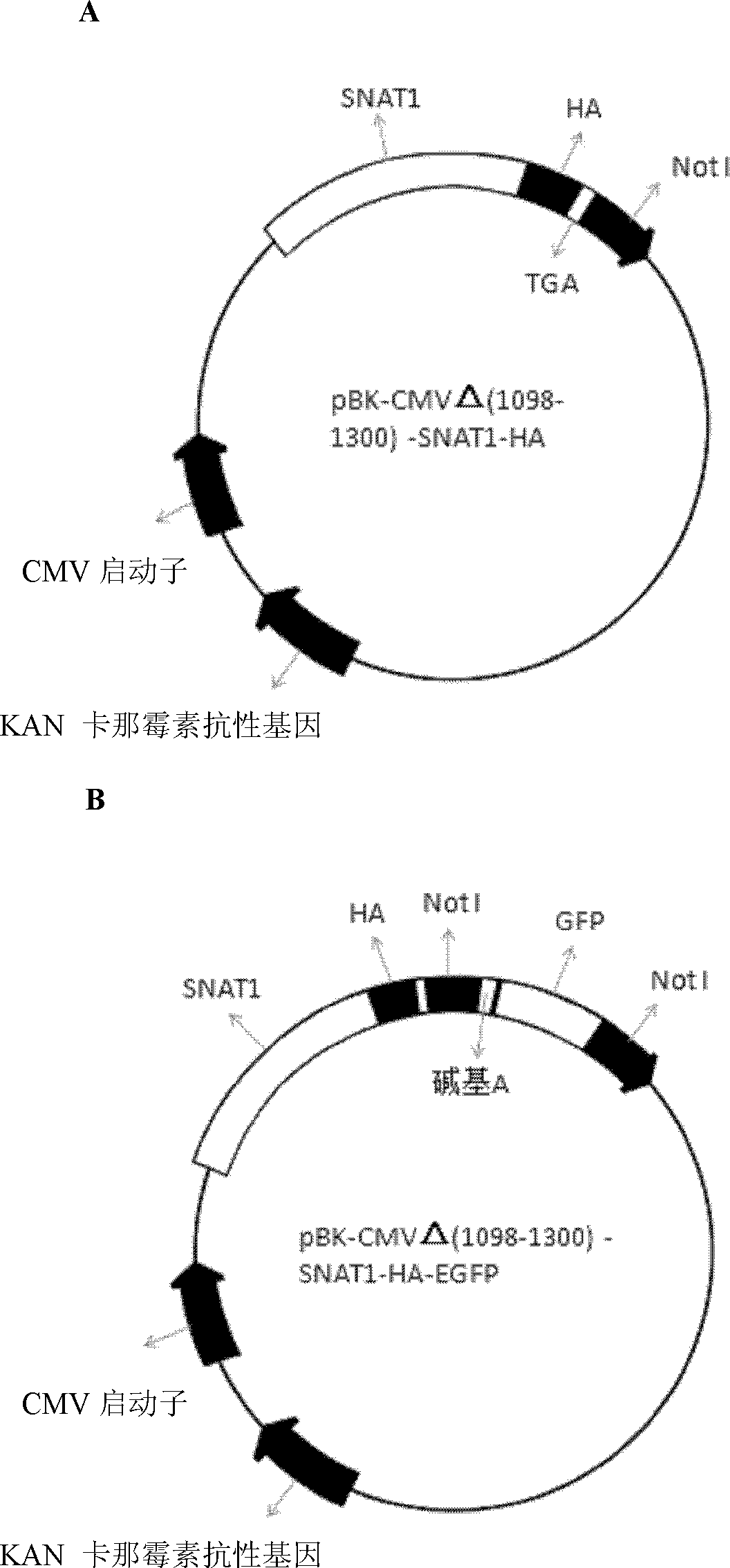Application of Glutamine Transporter 1 Fusion Protein Expression Vector
A transporter and glutamine technology, applied in the field of bioengineering, can solve problems such as expensive antibodies, difficult membrane proteins, and unsatisfactory results
- Summary
- Abstract
- Description
- Claims
- Application Information
AI Technical Summary
Problems solved by technology
Method used
Image
Examples
Embodiment 1
[0071] Example 1 Mass acquisition of the original eukaryotic expression vector plasmid containing the SNAT1-HA gene and the vector plasmid containing the EGFP gene:
[0072] The original eukaryotic expression vector plasmid containing rat glutamine transporter 1 and HA tag protein fusion gene (SNAT1-HA) is pBK-CMV (△[1098-1300])-SNAT1-HA, containing enhanced green fluorescent protein ( EGFP) gene vector plasmid is pMD-19T-EGFP.
[0073] Add 1ng pBK-CMV (△[1098-1300])-SNAT1-HA or pMD-19T-EGFP plasmid to 100μl of DH5α competent cells (TIANGEN). Gently rotate the centrifuge tube to mix the contents. Let stand for 30 min in the bath. Place the centrifuge tube in an ice bath at 42°C for 60-90 seconds, then quickly transfer the tube to the ice bath to cool the cells for 2-3 minutes. Add 900μl of sterile LB medium (without antibiotics) to each centrifuge tube. After mixing, incubate with shaking at 37°C for 45min (150 revolutions / min), mix the contents, and gently coat the plate contain...
Embodiment 2
[0076] Example 2 Amplification of EGFP gene
[0077] Using the plasmid pMD-19T-EGFP obtained in Example 1 as a template, polymerase chain reaction was performed to amplify the EGFP gene; reaction conditions: 94℃, 2min, one cycle; 94℃, denaturation for 30s, 66.1℃ annealing for 30s, 72 Extend at ℃ for 60s, 33 cycles in total; extend at 72℃ for 20 min. The reaction product is purified and recovered for sequencing and identification and the construction of the fusion protein SNAT1-HA-EGFP vector;
[0078] The specific primers used for PCR amplification of EGFP gene are:
[0079] EGFP-P1: 5’-gaatctatta GCGGCCGC aatggtgagcaagggcgag-3’,
[0080] EGFP-P2: 5’-ctatatagat GCGGCCGC tcacttgtacagctcgtccatg-3’.
[0081] The underlined part indicates the sequence of the NotI restriction site;
Embodiment 3
[0082] Example 3 Construction of pBK-CMV△-SNAT1-HA-EGFP recombinant
[0083] (1) Take 5.0 μg of pBK-CMVΔ-SNAT1-HA vector plasmid obtained in Example 1, perform a Not I single digestion reaction, incubate at 37°C for 3 hours, and recover the large vector fragment;
[0084] Take the 4.0 μg PCR amplification product obtained in Example 2 and perform a Not I single enzyme digestion reaction, and incubate at 37°C for 10 hours to recover the EGFP gene fragment;
[0085] (2) Use T4DNA ligase to ligate the large vector fragment and the small EGFP fragment:
[0086] The large fragment of pBK-CMVΔ-SNAT1-HA vector and the small fragment of EGFP which have been purified by restriction digestion were ligated with a molar ratio of 4:1, and the ligation condition was 16°C for 5 hours. The large fragment of pBK-CMVΔ-SNAT1-HA vector and the small fragment of EGFP are connected by NotI restriction site.
[0087] The resulting vector pBK-CMV△-SNAT1-HA-EGFP recombinant plasmid as figure 1 As shown in B, ...
PUM
 Login to View More
Login to View More Abstract
Description
Claims
Application Information
 Login to View More
Login to View More - R&D
- Intellectual Property
- Life Sciences
- Materials
- Tech Scout
- Unparalleled Data Quality
- Higher Quality Content
- 60% Fewer Hallucinations
Browse by: Latest US Patents, China's latest patents, Technical Efficacy Thesaurus, Application Domain, Technology Topic, Popular Technical Reports.
© 2025 PatSnap. All rights reserved.Legal|Privacy policy|Modern Slavery Act Transparency Statement|Sitemap|About US| Contact US: help@patsnap.com



